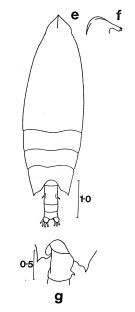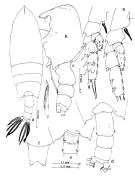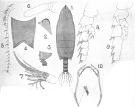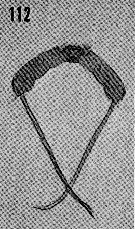|
|
 |
|
Calanoida ( Order ) |
|
|
|
Clausocalanoidea ( Superfamily ) |
|
|
|
Scolecitrichidae ( Family ) |
|
|
|
Scottocalanus ( Genus ) |
|
|
| |
Scottocalanus thomasi A. Scott, 1909 (F,M) | |
| | | | | | | Syn.: | ? Scottocalanus backusi Grice,1969 a (p.451, figs.F) | | | | Ref.: | | | A. Scott, 1909 (p.109, figs.F,M); Sewell, 1929 (p.184, Rem.F, Juv.F,M); 1948 (p.540, 552); C.B. Wilson, 1950 (p.340, fig.F); Vervoort, 1965 (p.57, Rem.); Owre & Foyo, 1967 (p.64, figs.F,M); Roe, 1975 (p.313, figs.F, Rem.); Park, 1983 (p.198, Rem.); Bradford & al., 1983 (p.116); Mulyadi, 1998 a (p.393, Redescr.F, figs.F); Mulyadi, 2004 (p.34, figs.F [no male], Rem.); |  issued from : H.S.J. Roe in Bull. British Mus. (Nat. Hist.) Zool., London, 1975, 28 (7). [p.312, Fig.9e-g]. Female (from Cape Verde Islands): e, habitus (dorsal); f, forehead and rostrum (right lateral side); g, genital somite (half lateral). Nota: The specimen has 2 spine-like projections on its genital somite (these projections are not always conspicuous, and they can be easily overlooked).
|
 issued from : Mulyadi in The Raffles Bull. Zool., 1998, 46 (2). [p.394, Fig.8]. Female (from Flores Sea): a, habitus (dorsal); b, forehead (left lateral side); c, last thoracic segment and urosome (left lateral side); d, idem (dorsal); e, distal corner of the last thoracic segment and genital somite (ventral); f, rostrum (frontal view); g, P2; h, P3; i, apex of P5.
|
 issued from : A. Scott in Siboga-Expedition, 1909, XIX a. [Plate XXVIII, Figs.10-17]. Male (from Banda Sea): 10, habitus (dorsal); 11, forehead (lateral); 12, last thoracic and genital segments (left side); 13, rostrum; 14, A1; 15, Mx2 (distal portion); 16, P2; 17, P5.
|
 issued from : A. Scott in Siboga-Expedition, 1909, XIX a. [Plate XXVI, Figs.1-10]. Female: 1, habitus (dorsal); 2, forehead (lateral); 3, last thoracic and genital segment (left side); 4, rostrum; 5, A1; 6, A2 (distal part of exopodite); 7, Mx2 (distal portion); 8, P2; 9, P4; 10, P5.
|
 issued from : H.B. Owre & M. Foyo in Fauna Caribaea, 1, Crustacea, 1: Copepoda. Copepods of the Florida Current. [p.64, Figs.411-412]. Female (15°00'N, 67°05'W): 411, rostrum. Male: 412, rostrum.
|
 issued from : H.B. Owre & M. Foyo in Fauna Caribaea, 1, Crustacea, 1: Copepoda. Copepods of the Florida Current. [p.64, Figs.414-416]. Female: 414, extremity of P5. Male: 415, P5; 416, left P5.
|
 issued from : H.B. Owre & M. Foyo in Fauna Caribaea, 1, Crustacea, 1: Copepoda. Copepods of the Florida Current. [p.25, Fig.112]. Female: P5. Nota: Subapical spine 4.5 times the length of the distal segment.
|
 issued from : H.B. Owre & M. Foyo in Fauna Caribaea, 1, Crustacea, 1: Copepoda. Copepods of the Florida Current. 1967. [p.64, Fig.415, 416]. Male: 415, P5; 416, distal part oo left P5.
| | | | | Compl. Ref.: | | | Bainbridge, 1972 (p.61, Appendix Table III: occurrence); Carter, 1977 (1978) (p.35); Vives, 1982 (p.292); Suarez & al., 1990 (tab.2); Suarez & Gasca, 1991 (tab.2); Suarez, 1992 (App.1); Gopalakrishnan & Balachandran, 1992 (p.167, fig.7, Table 1, 2); Suarez-Morales & Gasca, 1998 a (p.111) | | | | NZ: | 7 | | |
|
Distribution map of Scottocalanus thomasi by geographical zones
|
| | | | | | | | | | Loc: | | | South Africa (E), G. of Guinea, off Lagos, Cape Verde Is., off Mauritania, Caribbeanj, G. of Mexico, Florida, Indian, (Natal, off S Sri Lanka, between the South of equator to 20° S (in Gopalakrishnan & Balachandran, 1992), Bay of Bengal, Indonesia-Malaysia, Flores Sea, Banda Sea, Philippines, China Seas (South China Sea), Hawaii | | | | N: | 19 | | | | Lg.: | | | (5) F: 5,8; M: 6; (8) F: 6,08-5,92; M: 5,92; (16) F: 5,7-4,95; M: 5,55-5,48; (777) F: 5,78; (1122) F: 5,78; {F: 4,95-6,08; M: 5,48-6,00} | | | | Rem.: | Mesopelagic.
For Vervoort (1965, p.57) this species is characteristic, easily recognized by the peculiar, rounded crest on the head, present in both sexes, accurately described by A. Scott (1909) and Sewell (1929).
For Roe (1975, p.313) the females sampled from Cape Verde Islands agree with Grice’s (1969) description of S. backusi which is, in turn, very similar to S. thomasi. The females of these two species apparently differ only in the structure of their genital segment where S. backusi has a pair of spine-like protrusions.
Sewell (1929) described the genital segment of S. thomasi as having << a finger-like backwardly directed projection near the posterior margin a little to the left of the middle line >> ;
Roe examined a female specimen of S. thomasi in the collections of the British Museum (Natural History), which was taken at ‘Investigator’ Station 670 and presumably identified by Sewell. It has 2 spine-like projections on its genital segment (as shown in Fig.9e, g). These projections are not always conspicuous, especially if they are bent back alongside the genital segment, and they can be easily overlooked. For this reason I think it probable that S. backusi and S. thomasi are conspecific. | | | Last update : 09/12/2020 | |
|
|
 Any use of this site for a publication will be mentioned with the following reference : Any use of this site for a publication will be mentioned with the following reference :
Razouls C., Desreumaux N., Kouwenberg J. and de Bovée F., 2005-2025. - Biodiversity of Marine Planktonic Copepods (morphology, geographical distribution and biological data). Sorbonne University, CNRS. Available at http://copepodes.obs-banyuls.fr/en [Accessed December 24, 2025] © copyright 2005-2025 Sorbonne University, CNRS
|
|
 |
 |










